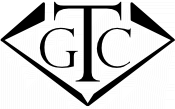- Recut Smokey Quartz trilliant


When I introduced myself to a jeweler, I like to explain the difference between my gemcutting and what is more commonly seen in the trade. I like to point out the fact that all of my stones are designed to be mounted. In choosing designs, I avoid sharp corners, overly thin or overly thick girdles, and bulgy bellies. Inevitably, the jeweler shows more confidence in using my stones.
Sometimes, my little presentation leads to a jeweler recounting horror stories. A jeweler once told me a story about a “quick & easy job” that turned sour. While trying to mount a large smokey quartz trilliant into a pendant, two of the three corners broke off beyond repair. He had a horrible time trying to pacify the client and replace the stone. When I met him, everything had been settled, but he still had the broken smokey & was still generally disgusted with the whole situation. I offered to recut the damaged stone for him, but he handed it to me with a request that it never return to his shop.
As soon as I saw the piece, I knew what happened. The bench jeweler put too much pressure on the corners when trying to mount the stone. Since there is damage on all three corners, I’m guessing that two of the corners were already mounted, but pressure from mounting the third caused two of them to break and one to chip. It’s possible that a more skilled stone setter could have finished the job, but it was the lapidary who set the whole thing up for failure.
In an attempt to maximize the weight and size of the stone, the original cutter chose to make the stone thin with very pointed corners. This confronted the bench jeweler with a double-challenge: sharp corners are always a chipping hazard and thin corners can break. Sadly, this bench jeweler ran afoul of both hazards.
In any event, I took the stone back to my shop and gave it a full recut. I removed the damaged corners completely (I certainly wasn’t going to make them thinner!) and improvised a design for the resulting shape. By correcting the pavilion angles of the stone, I was able to lighten the stone overall and give it some very eye-pleasing reflections.
Knowing how gemstones are used combined with careful cutting really does make a difference.
